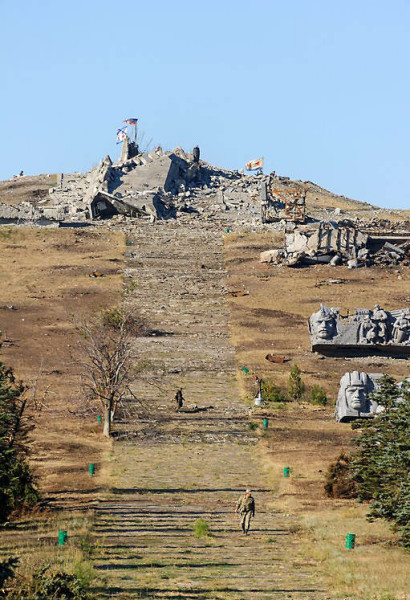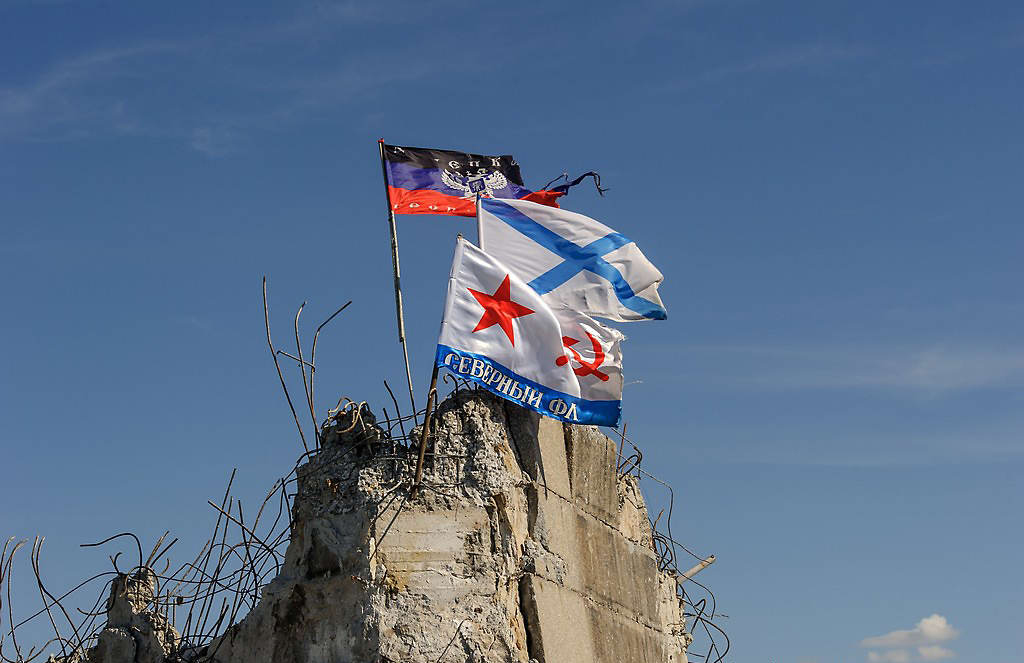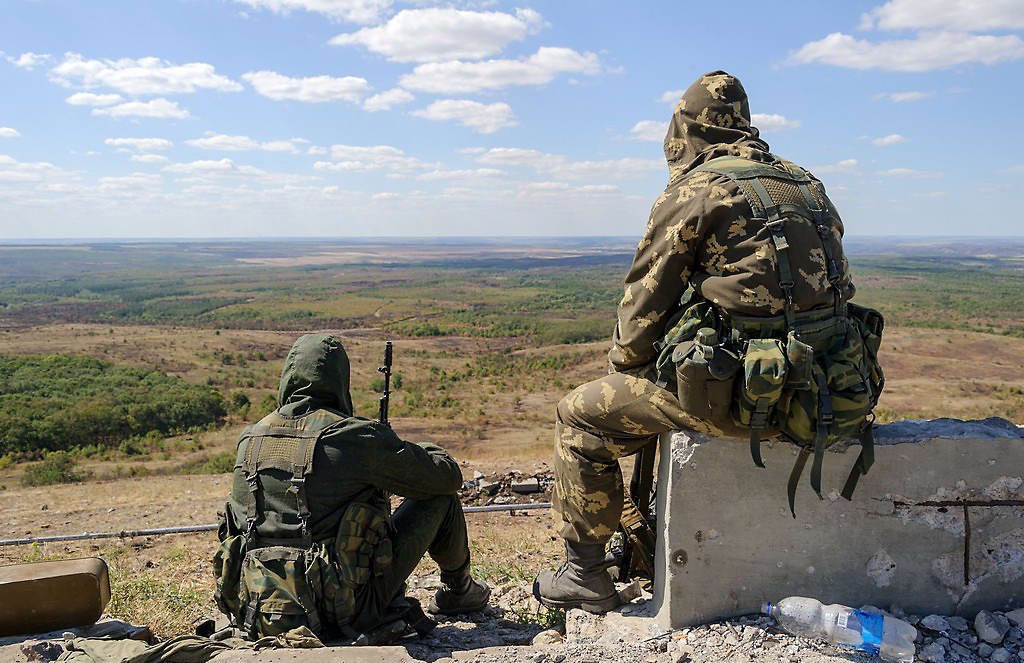In the frigid autumn sunlight I climbed the stone steps of Saur-Mogila. The burial mound, located atop a bluff encircled by the bronzed steppe, covers the bones of Soviet soldiers killed during the Second World War. More than 23,000 died fighting the Germans for this hilltop along the eastern edge of Ukraine, then part of the Soviet Union. The panoramic view from the summit is coveted for reasons both aesthetic and strategic, and I could easily see why. At 277 meters, Saur-Mogila is the highest point in the region.
It was Thanksgiving Day of last year, during Ukraine’s waning days of peace. With a friend I had crossed the border from Russia and hitchhiked my way to Saur-Mogila. Not long after my trip, Russian troops seized Ukraine’s Crimean peninsula and took it for their own, igniting a civil war over other territory in eastern Ukraine. Had I stood on the bluff eight months later, I would have had a dramatic view of Malaysia Airlines Flight 17—reportedly struck by a surface-to-air missile fired by separatists—as it hit the ground, killing all aboard.
Saur-Mogila—mogila is the Russian and Ukrainian word for grave—is one of the thousands of such burial mounds that dot Eurasia. It towers over the surrounding landscape, with the Russian border running past not far from its gentle eastern slope, the Ukrainian mining towns of Snizhne and Torez just to the north, and a rare swathe of undisturbed forests and scrublands beneath its sheer western flanks. The prairie-like steppe is stunning, its earthen undulations rolling across the terrain in all directions, but to a military mind the land has a hard-nosed logic to it: holding Saur-Mogila’s higher ground means holding sway over the surrounding terrain for as far as the eye can see.

It was a young Russian who brought me here. Thanks to a language-study grant from Oberlin College, I was spending the autumn of 2013 living just over the border in Russia. My home for three months was Taganrog, an unexpectedly cultured, architectural jewel of a town perched between sand cliffs on the Sea of Azov. My Russian visa demanded that I leave and reenter the country once every ninety days, and a brief visit to eastern Ukraine was the obvious option.
My friends assured me that industrial border town of Donetsk held nothing worth seeing besides soccer stadiums, so I decided to simply cross the border on foot, buy a Ukrainian bagel, and immediately return to Russia. The most accessible customs post is located on a rural section of very porous border, and I had every reason to expect suspicion, given my status as the rare American with no real reason for being there. Luckily, my friend Darya agreed to come along as a traveling companion and frontier troubleshooter.
As we trundled down the road in a rickety Korean minibus, Darya spotted a World War II monument. An eighteen-meter-tall steel anchor stood on a valley spur in the distance, marking one of many spots where Soviet infantry dashed themselves upon the machine guns and bunkers of the German defensive line on the Mius Front. Darya, a Russian patriot at heart, was suddenly inspired.
“I wonder … yes!” She began swiping at her iPhone, panning through the local equivalent of Google Maps. “When we cross the border, we should try to get to Saur-Mogila.”
“What is Sawragila?” I stuttered, struggling with that halting, clearly non-Russian name.
Darya’s enthusiasm morphed into a sense of duty, as her explanation turned to Russia’s wartime history. “But I simply most show you Saur-Mogila! I cannot let you go on thinking that it was some ‘allies’ who won the war.”
The West has long given the Soviet war effort short shrift, and indignant Russians long to set the record straight: the Germans lost more men to the Soviets than all their other enemies combined. The USSR, in the view of some, is the only Allied power that can really claim credit for victory over Nazi Germany.
The fighting over Saur-Mogila was part of the Soviet Union’s grinding assault on the Mius Front, an imposing system of fortifications that successfully warded off Soviet counteroffensives even months after the decisive Battle of Stalingrad devastated the German army. Built in a wide valley running alongside the muddy Mius River, the defenses stretched almost a dozen kilometers deep in some places, so strong they could only be overwhelmed by human-wave attacks.
Soviet forces suffered more than 800,000 casualties in these oft-forgotten struggles to break through the Mius Front. Here the Second World War began to resemble the First, a lethal stalemate of artillery and trenches, with conscripts herded into minefields and machine-gun fire—and, ultimately, up the flanks of Saur-Mogila itself. Masses of Soviet and German soldiers died for control of the bluff during the summer of 1943. In the summer heat, with the need to keep advancing, bodies were cleared from its slopes and piled up to be burned.

There were some obstacles to Darya’s planned visit. The bluff was over fifty kilometers away, accessible only by rural roads, with no public transportation to or from the border crossing. We would have to hitchhike.
At the Ukrainian border, the guards were incredulous when we told them our destination. Immediately they assumed we were lying and up to no good. The fact that Darya had apparently dragged an outsider into her scheme particularly irked them. One pointed a finger at me and demanded of Darya, “Aren’t you ashamed to be deceitful in front of a foreigner?” In the end Darya’s unflappable earnestness won them over, but the guards made us promise to bring back pictures of our destination, to prove we had no ulterior motives in Ukraine.
After we crossed the border, we proceeded by foot. Later, a driver let us onto his bus for free, and closer to Saur-Mogila we were able to hitch a ride with two young men, who drove us the rest of the way. The people of the border towns we visited, Darya told me, were very poor, with a sensibility located somewhere on the spectrum that distinguishes Russians from Ukrainians: taciturn, but kind. At one point our car stopped for fresh milk in a tiny hamlet, and Darya jumped at the rare chance to bring some home with her. When Russians speak of Ukraine, they begin to sound like Garrison Keillor, host of A Prairie Home Companion: the people are friendlier, the meat and produce are more natural, and Slavs are Slavs.
Our driver let us out some distance from Saur-Mogila, allowing us to appreciate the scale of its monolith and the steps ascending the slope. On the summit was a cast-iron statue of a soldier triumphantly brandishing his rifle, rendered in the blocky outlines of Socialist realism.
Most Soviet war memorials have an element of propaganda, extolling the country’s military might and depicting its dead as paragons of proletarian virtue. Saur-Mogila contained some of that—complete with tanks and artillery pieces parked at its entrance—and yet the viciousness of the Mius Front campaign was not entirely lost in the pomp.
The names of all the fallen were etched in stone at the mound’s base. Darya pointed out several instances of her own Dagestani surname.
“Can you imagine?” she asked as we stood on the summit. “What it must have been like to scale that slope, watching each grenade drop down towards you from above?”
Those days have returned. Like the Germans and Soviets seven decades before them, Ukrainian forces and their separatist foes have brought their war to Saur-Mogila. The pro-Russian rebels have re-excavated the very same trenches that protected the bluff in 1943. Many of them believe that this conflict—yet another struggle against “fascist” invaders from Europe—will ultimately lead to World War III.
Around the time of the Malaysian Airlines crash, the separatists broke holes into the granite obelisk itself, huddling inside to protect themselves from the intense bombardment. They drove their Buk surface-to-air missile system not far from the monument, to be concealed outside the nearby mining towns.
On a single day that July, more than 600 shells and rockets rained down on Saur-Mogila. Video footage shows their clouds of brown dust blossoming all over the hill. For several weeks, the statue of the gun-waving soldier stood spattered with shrapnel. Artillery and airstrikes ultimately reduced it to a pile of iron scrap.

Back in Taganrog, Darya’s father entertained us with anecdotes, vodka, and port wine. At one point he raised his glass in a toast.
“That there will not be war.”
Taganrog’s military airbases are now full of Russian soldiers. Our border crossing has been shelled repeatedly. The guards and locals have fled.
Seven decades after the Soviet push against the Mius Front, Russian troops are once again in Ukraine, this time not to fight a foreign army, but to support separatists. As for Saur-Mogila, the viewing platform has disintegrated into the scorched grass, and the wall of names is badly pockmarked. The obelisk has toppled over, collapsing at the base after the monument was overrun by the Ukrainians and the rebels in quick succession.
Those poplar-lined roads through the steppe have changed since we drove them. They may as well belong to a vanished Ukraine of years past. Standing on Saur-Mogila’s bright summit and thinking of its battles long ago, I could not have dreamed of a new war so soon to come.
Michael Long is a freelance writer who has studied in Saint Petersburg and worked in Taganrog and Moscow. Sergei Kopylov is a photographer based in Taganrog.
- Follow us on Twitter: @inthefray
- Comment on stories or like us on Facebook
- Subscribe to our free email newsletter
- Send us your writing, photography, or artwork
- Republish our Creative Commons-licensed content

